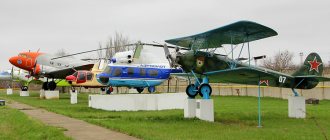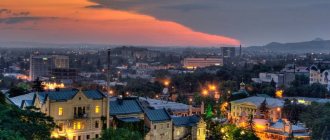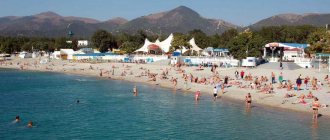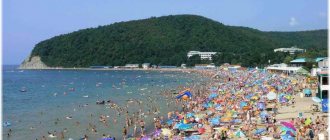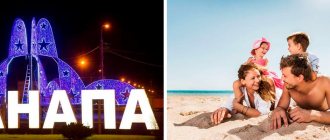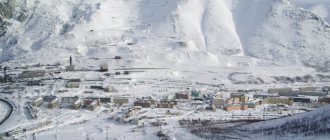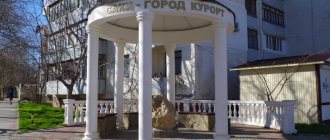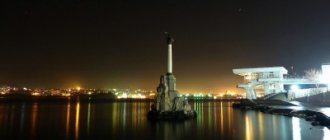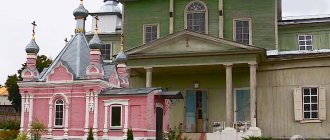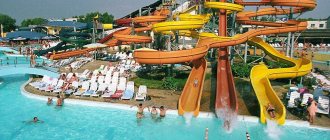Writing about your hometown, having left it, and now having the opportunity to look at your native distances with an open mind years later is an amazing feeling, like a story about your parents, who are getting younger and prettier with age. Defying the laws of physics and time.
So, Mineralnye Vody. Is it worth coming back here or is it better to leave and forget forever? I chose the middle path. I live in Moscow, but I come for a month or two every year. I’ll tell you literally everything I know, so it won’t be possible to quickly finish reading the review.
It was and became
Previously, in Soviet times, the city performed a great practical function for the resort towns of the KMS - people flew here and came on vacation from all the places in the USSR where there were airports. The sanatoriums were literally working hard all year round; the concepts of “high season” and “low season” did not apply to this region.
Since such a huge country was behind the Iron Curtain, the choice of holiday destinations was not particularly diverse: Crimea, the Black Sea coast, Kavminvody were key points of relaxation, the “gold standard” where you could get a ticket or come on your own to find accommodation on the spot.
However, the daily rental of real estate was not thriving then, to put it mildly, so people flew to the CMV, as a rule, with ready-made vouchers from trade unions. This means that the vacation was organized, cultural, under the supervision of various comrades who controlled the “shape of morality”)) Not without excesses, dramas and adultery, but all this happened behind the walls of medical institutions, and therefore did not affect the local residents in any way. There is no comparison with Adler, Sochi, Tuapse, Anapa, where the streets are full of life 24 hours a day)))
Photo by zdubii
Discotheques with pioneer leaders, as on the Black Sea coast, and various other drinking chacha were not observed here, and this is still the case. Unless some kind of showdown will happen between our dear closest neighbors from the southern republics, whose blood always boils, and indignation demands immediate revenge, but this is already a rarity.
In terms of nature and air purity, Kavminvody is really no worse than Switzerland, it is just necessary to invest sufficient funds in them and modernize them. And, I must say, the region is slowly moving in this direction.
But let’s return to Mineralnye Vody - the point of departure to this sanatorium paradise - and the problems that tourists and migrants may encounter.
Hot Springs
There is only one hot spring town in the region. What is he famous for?
Zheleznovodsk
The advantage of the resort is its high-temperature springs, unique for Europe, with carbonic sulfate-hydrocarbonate waters of medium mineralization.
There are 16 springs in Zheleznovodsk, the effects of which have been tested by time.
Balneology of the 21st century combines the therapeutic effects of healing waters with modern procedures, enhancing the natural effect.
What's going on with tourism now?
Nothing has changed since the time of the USSR - the city continues to perform a transport function, now, however, mainly thanks to Russian Railways. No, the airport is open, but how much the number of flights has decreased!
In the Soviet years, when I was little, I lived on the landing line, so I remember very well that planes descended literally every 5-10 minutes - I forever remembered what their bellies looked like. Now Moscow has become the main transport hub, from where those wishing to transfer to the desired destinations. That’s why planes fly mainly from Mineralnye Vody to Moscow, and much less often to St. Petersburg. In addition, they are introducing and then closing experimental flights to Ekb, Perm, Orenburg... And Turkey, the UAE, Egypt appeared after the USSR, and these, of course, are not regular flights, but charters, thanks to which a duty store finally appeared at the airport free.
In addition, Minvody has become a small transfer hub for those wishing to travel to the south of Russia - as a rule, here you can fly to Voronezh, Rostov, Adler, etc., but not on a regular basis, you need to look at the schedule in advance, this is not a train that will for sure.
My childhood home is still located on the plane landing line, but now, having arrived, I hear them no more often than once every two to three hours. It's for the better.
But the railway station is quite thriving - it is a junction station, where many important things happen - all sorts of technical issues, recoupling of cars, etc. Although all trains (except those coming from North Ossetia and the Kabardino-Balkarian Republic) leave from the Kislovodsk depot, it is here in an hour they are being prepared for their final departure to greater Russia. There are a lot of trains, all of them are packed both in season and in winter, because, as it turned out, the FSS buys up most of the vouchers to sanatoriums for various categories of beneficiaries, so they come from all over our Motherland. And this is good, the region will not be left without a piece of bread.
Apparently, in Kislovodsk and other nearby cities of the Caucasus there is no point in maintaining a developed railway infrastructure, so Minvody serves all passing trains. Because of this, any train stands here for at least 30 minutes - it doesn’t matter whether it’s leaving or has already returned. The only exception is the extremely fast two-story Kislovodsk-Moscow, which allows exactly five minutes for boarding, and it is very easy to be late.
Having arrived in the city, vacationers take the train or immediately take a taxi. After walking around the city, they go to different KMS sanatoriums or rented apartments, and sometimes even take long trips - Arkhyz, Dombay, Elbrus region and even further. By the way, I was pleasantly surprised by how the taxi system in Minvody has changed, which earlier, in Soviet times, caused a feeling of powerlessness due to the arrogance of drivers. Of course, there are popular taxi aggregators with incredibly low prices, but I didn’t like it. The drivers are angry because of the low pay and slave labor, they are afraid of a low rating in the application, sometimes they are not very adequate... As a result, normal professional drivers agreed among themselves and fought back against the aggregators, creating an exclusively local taxi service on the CMV, which began to transport tourists, literally licking them. The service is right at the business class level, I liked it when I went to Dombay like that once. Of course, there are barkers at the airport and train station, but these are still the same good old drivers “looking for a sucker.”
The railway station and the airport look nice (you can look at them on Google Maps, I didn’t dare take pictures, they say that due to Soviet inertia the police do not approve of this). Yes, they are small, but clean, modern, and quite suitable for a transit stay.
The infrastructure around the station is constantly being built, sometimes they will dig up the asphalt (for a short time), sometimes they will make a fountain, but all this, in principle, is for the good, there are results.
Transport
Public transport connecting the resorts is represented by minibuses, intercity buses, trains and taxis.
The minibuses are inexpensive, but they are always crowded and run out early. The chance of leaving for a neighboring city after 21:00 is almost zero, only a taxi. Although there are positive changes, they recently launched a new route Zheleznovodsk - Kislovodsk: a comfortable large bus, a clear schedule, but only 4 trips a day. Intercity flights have reasonable schedules and are suitable for those who live near the bus station. Fares are low, but for some buses you cannot buy tickets in advance; you will have to be on duty at the ticket office.
Electric trains are good - clear schedule, new cars, no traffic jams, friendly conductors, reasonable prices - a full ticket from MinVod to Kislovodsk - 184 RUB. The disadvantage is still the same - the last train from Kislovodsk (this is the final train) leaves before 21:00.
It is better to buy train tickets at the station. Otherwise, you will have to pay the conductor an additional 50 RUB for “providing services for issuing travel documents.”
So far, large taxi operators have not entered the KVM, and this is sad, since the amount of a trip for private owners and even employees of local taxi companies is an ephemeral concept. 300 RUB easily turns into 400, and 450 RUB into 600, it all depends on the mood, weather, time of year and day, as well as the driver’s considerations about the client’s solvency. Harsh resort reality.
How do the locals live?
Ecology - well, not Zheleznovodsk, of course, there are still cars, but it still can’t be compared with Moscow, the air is very different for the better. No factories emitting unknown things into the water and air, no traffic jams on the Moscow Ring Road saturating the air with gases.
Locals like to complain “oh, the water is so-so,” but this is not true. Mineralnye Vody has simply magnificent, soft water compared to big cities. Over the past winter, I simply ruined my skin with Moscow water, it began to peel off so much that no creams helped. And at home, just by taking a shower several times, I restored her to her normal state without the help of cosmetologists. Moreover, while living here, I have never gone to various beauty injections and similar maintenance procedures in my life. All this had to be done in Moscow...
The negativity regarding the environment is perhaps the lack of awareness of the citizens themselves. The city has a huge Snake Mountain, the heart of the city. There is a highway next to it, it seems that it used to be called “Rostov - Baku”, but since the highway is sort of outside the city and does not have much traffic, residents do not suffer from its presence. And they suffer only from their own brothers.
On the aforementioned Snake, for example, people love to barbecue, drink, and have fun, starting in early spring and, despite the threat of catching a tick, they do this around the clock. In principle, this does not interfere with the city - on the contrary, all particularly bright drunken performances take place outside the residential area and this is great. But these vacationers leave behind garbage, because of which, when they come to the barbecue, they have to look for a long time for a place to relax. The administration sooner or later cleans up after these pigs, but there are so many of them that it’s impossible to clean everything up.
The city center is simply clean in a European way, but if you go somewhere beyond the courtyards of the central streets - and behold, our entire culture is down to the penny - plastic bottles, cigarette butts... Thank God, not syringes, but in the 90s there were a lot of them lying around. Apparently, lovers of this rubbish have died out, and such things are no longer fashionable among young people.
It’s great that modern, creative coffee shops have opened; for those who like to drink something stronger, there are no less cool cozy pubs with various types of craft drinks and snacks. Prices in the latter are much lower than in Moscow, but you need to know what is worth drinking and what is so-so. There are no overtly drunk people or homeless people in the city, at least not yet. There used to be a lot of them, but with the beginning of the 2000s, they also disappeared somewhere, like syringes.
The city has representatives of all online stores, several Internet providers, a good shopping mall, Fix Price and Four Price, a family hypermarket "Magnit", many "Pyaterochka" and private grocery stores. Among the federal cafes there are Dodo and KFC, the rest are local, but very interesting. Many visitors, for example, like the Fat Cat pizzeria - much cheaper and no worse. Sushi and WOK are also quite up to par, they look absolutely like provincial cafes. Other McDucks and Burger Kings are available in neighboring Pyatigorsk, 20 kilometers away. In the center there is a city market that has been operating here since shaggy times, and nothing, nothing changes inside, it’s amazing. There is everything here, even a second-hand store that has been operating since the early 90s. To be honest, from the outside it looks like a point of sale of illegal weapons, and not a cozy shop-bar, which should dispel the embarrassment of visitors. However, if it works, it means there are clients. Inside the market there is literally everything that is needed in the closet, in everyday life and on the table, this is a miniature copy of the Moscow “Gardener”. I think that's where the goods are brought from.
The specialty of the city is private meat shops a la “Meat at Misha’s”, “Meat at Volodya’s”, etc., where you can buy everything for barbecue - a cheap but durable grill, skewers, charcoal, spices for marinade, etc. Yes, barbecue is very popular, have I already mentioned this?)) Everyone who can take the meat and go out, or, at worst, fry it in the courtyards, although since the new year this seems to be prohibited.
And, in principle, it’s good that you don’t have to go to a cafe and overpay for being there and need to chip in for waiters’ salaries, rent, etc. In the Mineralovodsky urban district there are many places, in addition to Zmeyka, where you can go to relax, including rivers and lakes, so it’s easy to organize a spontaneous vacation, not to mention the fact that there are many lakes and rivers in neighboring cities nearby. As long as the garbage is collected, fire safety precautions are followed, and people can rest. But if you arrange a vacation in a place where this is not required by law, you can run into a hefty fine. And also - if you are caught in the vicinity of the mountain, collecting flowers listed in the Red Book. The fines are real, it's not worth the risk.
There are a lot of children in the city, the queues for kindergarten are quite real, but still not the same as in Moscow. Yes, by the way, there are a lot of old people and children, and this is rare - as a rule, there is a bias in one direction or another, but no, here everyone is equally divided. I note that this is only a visual impression, and city statistics may differ from my opinion. Older people live here longer than in environmentally unfavorable places, and young people are having trouble giving birth, despite low salaries.
Rent a Car
If you plan to have a full-fledged wellness course, then you simply won’t have enough time to travel around cities. Otherwise, a car will be very useful, given the dubious quality of local public transport. By car - half an hour to any of the cities of the resort conglomerate, 3 hours to Dombay, Arkhyz or Elbrus, in 4 hours you can drive to Chechnya and admire Grozny at night.
After a working day, the roads around Pyatigorsk are jammed with monumental traffic jams; it is better to avoid this direction in the evening hours.
Things are different with parking: Pyatigorsk and Kislovodsk are crowded with local residents, but you can park a car, in Zheleznovodsk there will be no problems, but in Essentuki they don’t like cars and hinder them in every possible way, it’s better to immediately select housing with a parking space.
Rental services are mainly carried out by local players - “Rental AUTO KMV”, “Avtodar”, Autorent-KMV, Urentcar and others. The car can be delivered to the airport or hotel. For a day in economy class they ask from 1000 RUB. Deposit - from 3,000 RUB.
Yes, by the way, about salaries and prices
Well, they are not high, what can you say))) 20–25 thousand rubles before taxes for an unqualified position a la salesman. 35 is already a senior manager or director of a store branch. Engineers and others working under a contract with Moscow in one area or another receive more, but, as a rule, this is project work and not a permanent salary. In general, everything is sad with creative vacancies, the market is saturated with creatives, at least thanks to the former Pyatigorsk Foreign Languages Institute (now simply Pyatigorsk University), so such specialists can only try themselves somewhere in Pyatigorsk (life is more vibrant there), or switch to remote work. The labor market in Mineralnye Vody can be easily viewed on the relevant headhunter sites; they write the absolute truth there.
Housing and communal services are cheaper than in Moscow, but not by much. The houses are cleaned and not abandoned, for this honor and praise go to the utility workers.
There are more private buildings in the city than high-rise buildings; Delving deeper into the courtyards, I feel like I’m in a well-kept town at the crossroads of cultures. The Soviet Union, the North Caucasus, modern Russia - everything is intertwined here. The houses are only stone or brick, at worst, adobe covered with brick, there are no wooden buildings at all. Residents love their yards and take care of their surroundings no worse than Europeans. The asphalt, however, fails in some places, but not critically. Just as it wasn’t in these areas 25 years ago, it won’t be now, why is it needed, everyone is already used to it.
KavMinVod Hotels
The KMV hotel market (excluding sanatoriums) is not particularly rich, although the range of options is wide - from a bed in a hostel for 1,000 RUB to luxury suites for 35,000 RUB. The fund is distributed unevenly - in Zheleznovodsk the choice is meager, in Pyatigorsk it is better, and Kislovodsk is frankly pleasing. Often these are small 2-3* hotels, apartments that turn out to be apartments in high-rise buildings, as well as guest houses. Prices for apartments start from 800 RUB per night.
If you decide to undergo treatment, but not live in a sanatorium, it is better to settle in close proximity to drinking galleries and medical buildings - there may simply not be enough time for the rest. If traveling involves a car and getting to know the region, then you should look for a secluded guest house away from the hustle and bustle - on the picturesque resort outskirts.
Medicine
The question is not easy. There are two hospitals, a city and a railway, a good maternity hospital, a antenatal clinic, as well as several paid specialized medical centers and laboratories for taking tests. Analyzes from all laboratories fly to Moscow and are performed only there... However, Biotest seems to do them in Pyatigorsk. It is quite difficult to get a free voucher to see a specialist, but it is quite possible to make an appointment with the same therapist on the Internet; moreover, you can also make an appointment with other doctors in the CMS region. But the flow of patients is large, and my relatives prefer to go to paid doctors without waiting in line. And a railway hospital is, in fact, the same paid medical center, in which only Russian Railways pensioners and active employees, as well as members of their families, have the right to free treatment.
Guides at Caucasian Mineral Waters
All guides at Caucasian Mineral Waters
Excursions by Tatyana Anatolyevna Krivosheina
- Tseyskoye Gorge of North Ossetia
- Arkhyz
- Elbrus
All 8 excursions
Excursions
- Horse ride
- Pilgrimage to the relics of St. Theodosius of the Caucasus
- To Kislovodsk - the city of the sun and Narzan
All 37 excursions
Excursions
- Jeeping in the Kurtat Gorge, Dargavs, Karmadon
- Tour to Mountain Chechnya
- tours to Sochi from Pyatigorsk
All 30 excursions
Excursions by Svetlana Grishina
- Climbing Mount Beshtau
Excursions of Akhmat Khisaevich Korkmazov
- Neighborhoods of Kislovodsk. Day of good impressions
- Bermamyt Plateau - a living legend
- Ancient Alan settlement in Nizhny Arkhyz. Legacy of Byzantium
All 4 excursions
All guides at Caucasian Mineral Waters
Attractions
The main attractions of the KMS are the local nature and architectural monuments. Lovers of walks will find wonderful parks, each of which is more than 100 years old - “Tsvetnik” and Emmanuel Park in Pyatigorsk, Zheleznovodsk Resort Park, Victory Park and Resort Park in Essentuki, Kislovodsk Resort Park and the Valley of Roses. Local parks are not only lush greenery and clean air; around every turn of an alley or path you can suddenly see an unusual fountain, a sculptural composition, or even the palace of a real Bukhara emir. In addition, almost every park has pavilions and galleries with mineral water sources. By the way, not all galleries are about mineral water. Concerts and art exhibitions are held in the lace and airy Pushkinskaya in Zheleznovodsk, as well as in the toy palace of the Lermontov Gallery in Pyatigorsk.
Mud and hydropathic centers, as well as mineral water sources, are a separate topic for an excursion for more than one day. Some amaze with their architectural solutions, sophistication or monumentality, while others sadden with their current state. For example, the beautiful building of the Ostrovsky Baths in Zheleznovodsk is deteriorating - once a leading medical institution, now an abandoned and fading monument.
Another excursion point is famous people who visited the Caucasus. Pirogov was treated here, Chaliapin sang, Ilf and Petrov helped Pyatigorsk Proval become famous, not to mention Lermontov, who was treated as a child at the KMV, lived as a disgraced poet, worked and died in a duel. Some prominent figures of culture, military affairs and science can be visited at the Pyatigorsk necropolis. The cemetery has been closed for more than 100 years; now it is an open-air museum with many beautiful monuments. And one of the heroes of bygone days still wanders like a ghost in an abandoned mansion.
Important non-man-made attractions are the immature volcano of Iron Mountain, the Permafrost Grotto of Mount Razvalka, Koltso-Mountain near Kislovodsk, Hot Mountain and Mashuk.
Weather
The diversity of the relief creates noticeable differences in the climate of the resorts of the Caucasian Mineral Waters. In Pyatigorsk, summers are warm, winters are moderately mild (a third of winter days include rain, thaws, and fogs) and there are 98 clear days a year. Kislovodsk is famous as a winter climatic resort, the winter there is clear and dry, and the number of sunny days per year is 150. The resort also stands out for its constant atmospheric pressure, which has a beneficial effect on the healing process. The climate of Zheleznovodsk corresponds to the mountain-forest and moderately dry climate of the middle mountains of the Alps. There are 117 clear days a year here. Essentuki is distinguished by its contrast - summers are hot and dry, winters are frosty and rainy, the number of clear days a year is 112.
